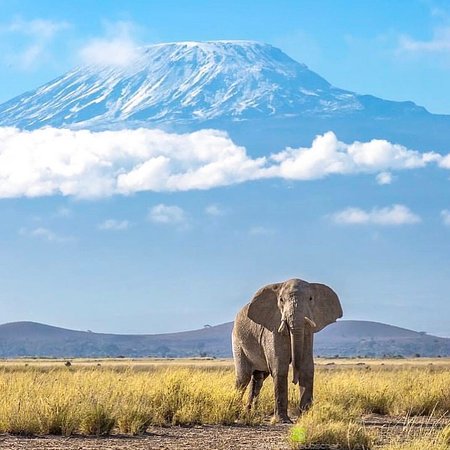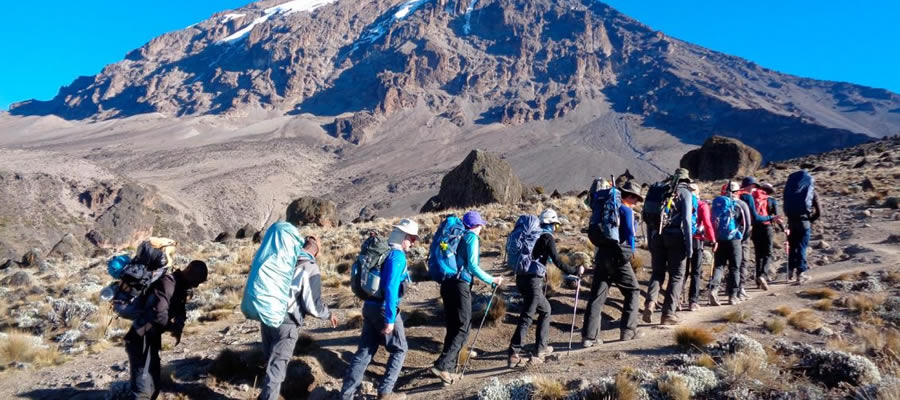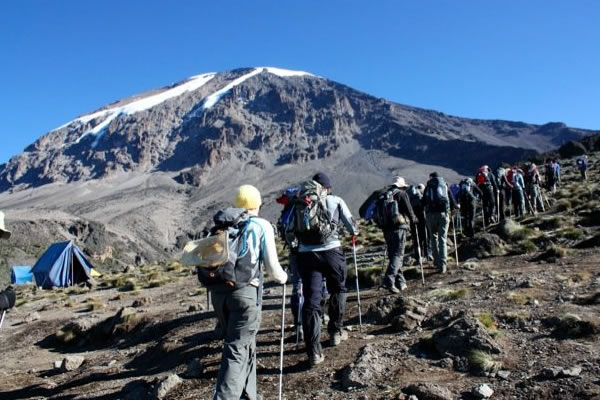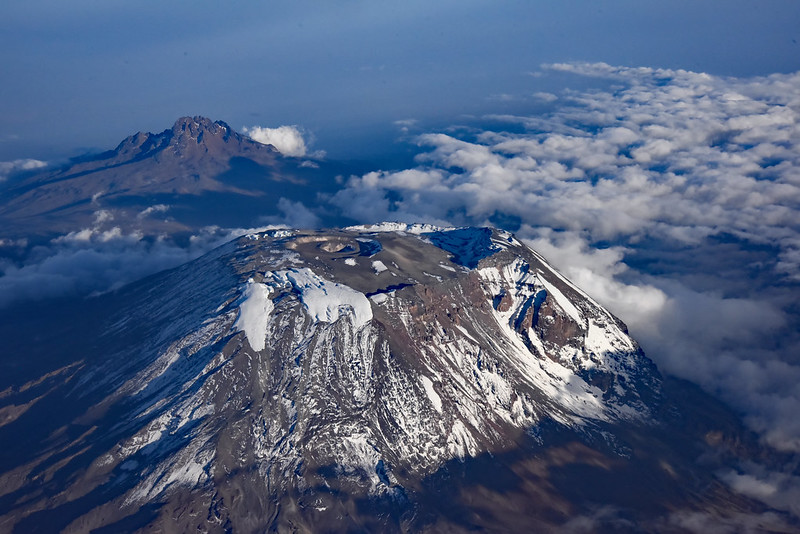Mount Kilimanjaro , Africa’s highest peak, is a free-standing, snow-covered dormant volcano in East Africa, Tanzania country. Kilimanjaro attracts 75,000 mountaineering enthusiasts each year, so it is neither the most remote nor the most difficult. It is, however, a true test of endurance, with altitude sickness being the leading cause of climbers’ failing to reach the summit of Kilimanjaro (Uhuru peak). Despite the fact that it has become a very popular challenge and the experience has grown somewhat crowded with other climbers, we nevertheless strongly suggest it to everyone with a passion for mountaineering.

Mt. Kilimanjaro is located in northern Tanzania, close to some of Africa’s best safari parks, so it would be a shame not to visit the Serengeti, Ngorongoro, or Tarangire while on an ascent to the mountain. You can ask us about how can you combine your East African safari itinerary with a climb of Kilimanjaro for a more safari experience in your Africa tour holiday.
ABOUT MOUNT KILIMANJARO
Kilimanjaro is Africa’s tallest peak and the world’s highest freestanding mountain. It is a dormant volcanic mountain with three cones: Kibo, Mawenzi, and Shira. Kilimanjaro is a non-technical climb, unlike the other Seven Summits (the highest mountains in each continent). This means you don’t have to be a seasoned mountaineer to take on the challenge; yet, it is not for the faint of heart and demands some fitness and preparation. The majority of hiking routes may be completed in seven days or extended to nine days. We recommend taking as much time as possible to better acclimate to the elevations and climates.
A six/seven-day climb up Kilimanjaro takes you through five distinct temperature zones. The journey begins in the lush rainforest of the lower slopes, which is rich in animal and plant life. As you rise, the vegetation thins out until you’re left with nothing but a stark ice cap.

HOW TO GET TO KILIMANJARO? / HOW TO ACCESS KILIMANJARO?
Kilimanjaro International Airport is the closest airport to Mount Kilimanjaro. Normally, flying from the United Kingdom to Kilimanjaro necessitates a connecting flight. After that, you’ll need to transport to either Arusha or Moshi (depending on where you’re starting your Kilimanjaro trek from) for about 45 minutes. Another option for getting to Mount Kilimanjaro is to take a flight and land to Kenya’s Jomo Kenyatta international airport then from there drive or take a domestic flight to Tanzania.
HISTORY OF CLIMBING KILIMANJARO
Hans Meyer and Ludwig Purtscheller were the first individuals to hike and reach the peak of Kilimanjaro in 1889. Approximately 30,000 people visit Tanzania each year to climb Uhuru Peak (Mount Kilimanjaro largest peak), and approximately two-thirds of those who attempt it succeed.
Karl Egloff, a Swiss-Ecuadorian athlete, set the record for the fastest ascent and round trip when he reached the top in 4 hours and 56 minutes and returned to Mweka Gate in 6 hours. Boy Coaltan Tanner, who is only six years old, is the youngest person to climb Kilimanjaro. Anne Lorimor, who is 89 years old, is the oldest individual to summit to the peak of Mount Kilimanjaro.
KILIMANJARO’S FORMATION
The world’s tallest free-standing mountain is a dormant stratovolcano produced by fire and ice. The Shira volcano was formed when lava erupted through the cracked surface of the Great Rift Valley over 750,000 years ago. The eruptions that followed formed Mawenzi and Kibo.
Kibo, Mawenzi, and Shira are the three cones that make up Kilimanjaro. Kilimanjaro’s top is located on the Kibo cone, which is dubbed Uhuru peak, which means freedom in Swahili. Mawenzi and Shira are both extinct volcanoes, whereas Kibo is thought to have remained dormant after the last big eruption 350,000 years ago.
KILIMANJARO’S FLORA AND FAUNA
On your Mount Kilimanjaro Trek, you will see tropical jungle, savannah, desert montane, subalpine, and alpine vegetation. Large animals are uncommon on Kilimanjaro, but buffalo have been seen on the Shira Plateau and giraffes have been seen wandering the lower slopes. On Kilimanjaro, though, you’re much more likely to see a wide variety of species, from Malachite Sunbirds to mountain buzzards and even crowned eagles.
KILIMANJARO’S CLIMATE
The wet seasons on Kilimanjaro are March to May and November, with the northern slopes receiving far less rain than the southern slopes. The average temperature at the mountain’s base is between 21 and 27°C, while the average temperature at the peak is around -7°C. Snow can fall at any time of year, but the two rainy seasons are the most common.
WHAT IS THE HEIGHT OF KILIMANJARO?
Kilimanjaro is the world’s highest free-standing mountain, and if you reach the top, you’ll be standing at 5,895 meters (19,340 feet) above sea level. It’s also known as Africa’s roof since it towers above East Africa and the entire continent for that matter. It’s so large that you can’t really see it if you’re standing at the bottom.
WHERE IS MOUNT KILIMANJARO LOCATED?
Mount Kilimanjaro should not be confused with other prominent African mountains such as Mount Kenya or Morocco’s Atlas Mountain. Mount Kenya is located in Kenya, and Mount Kilimanjaro is located in Tanzania, East Africa. Mount Kilimanjaro is located just adjacent to famous safari parks such as Arusha national park, Lake Manyara national park, Tarangire national park, Ngorongoro crater and Serengeti national park. Also Mount Kilimanjaro is close to Kenya’s Amboseli national park.
HOW LONG IT TAKES TO CLIMB MOUNT KILIMANJARO?
Depending on the route and pace of the itinerary, hiking Mount Kilimanjaro might take anywhere from five to ten days. Occasionally, a few daring record-breakers have done it in just one day. Treks differ in length and duration. As a general rule, the more gradual the increase, the slower it will be.

THE COST OF CLIMBING MOUNT KILIMANJARO
The cost of climbing Mount Kilimanjaro differs/ vary depending with different factors such as you hiking route, number of days you spend in the mountain, number of people etc. however the average cost of climbing Kilimanjaro is $2000 to $6000, with prices ranging from low-cost budget operators to huge Western travel agencies overcharging for outsourced expeditions. Any trip operator has a variety of inescapable fixed charges, and if a climb appears to be excessively inexpensive, you must ask yourself why. For more information about cost of climbing Mount Kilimanjaro please contact one of our traveler consultant (Focus East Africa Tours) for more accurate cost and wisely hiking plans.
WHEN IS THE BEST TIME TO CLIMB MOUNT KILIMANJARO?
If you’re trying to figure out when the best time is to climb Kilimanjaro, you should realize that you have a lot of possibilities. Mount Kilimanjaro does not have any season restrictions, so you can begin your climb at any time of year. Of course, there are peak and low seasons, and if you’re looking for the best time to climb Kilimanjaro, you should know that the most popular months to visit climb to Kibo, Mawenzi, and Shira are January to March and June to October, respectively. From January through March, the first peak season of the year, there is a greater likelihood of seeing snow on the top. You won’t see any snow between June and October, but you will see a lot more people. This is due to the fact that a large number of people from Northern Europe and North America choose to spend their summer vacations in Tanzania.
If neither of those periods appeals to you, you can climb Kilimanjaro during the low season. March, April, and November are the wettest months. It’s worth noting that the lower slopes of Kilimanjaro can get rather muddy during the rainy season. If you’re searching for a great route to go on during these months, the Rongai Route is a great option.
OVERALL MOUNTAINEERING FITNESS REQUIRED FOR CLIMBING KILIMANJARO
Although it is feasible to walk to the summit of Kilimanjaro without using professional climbing equipment, it is a difficult and serious undertaking that needs a high level of physical fitness, stamina, and a realistic understanding of the potentially harmful effects of high elevations. Before attempting to scale the mountain, several tour operators recommend that hikers/hikers/climbers contact a doctor and undergo a physical examination to assess general fitness.
HOW DIFFICULT IS IT TO CLIMB MOUNT KILIMANJARO?
The majority of the days climbing Kilimanjaro are not difficult because the paths/routes are not steep; instead, it is primarily about adjusting to the altitude; nonetheless, the summit night is incredibly challenging because it is the coldest and windiest part of your journey. A climb of 4,084 feet and a fall of over 6,870 feet with 49% less oxygen.
Climbing Kilimanjaro will be challenging for someone who is extremely old or really young. Despite this, the youngest Kilimanjaro climber is only 6 years old. If you are severely overweight or crippled, you should probably abandon your plans to reach Uhuru Peak.
THE ROUTES TO MT. KILIMANJARO
The Lemosho Route is a slightly more relaxed route that allows for 8 days of acclimatization and has a decent balance of camp site heights. The scenery is breathtaking as you walk through forests and over bridges. Uhuru Peak has an 88 percent success rate, whereas Stella Point has a 94 percent success rate.
The Machame Route is the most popular, and as a result, it can get quite crowded. It has surpassed the Marangu Route in popularity, and while it offers excellent views of the mountain from the west, we believe its popularity has hampered its quality.
Northern circuit route, because the Northern Circuit is a 9-day hike, almost everyone reaches the peak. It’s possible to do it in 8, but 9 is a little more casual. It is for mountain fans as well as those seeking isolation on the mountain—which is rare on Kilimanjaro—so this is a nice addition to the Northern Circuit path.
The Rongai Route, It starts the trek up the mountain’s northern flank and is unrivaled in terms of view and summit achievement. There is some flexibility here as well, as you can add a day to give yourself more time to acclimate and improve your chances of summiting. The 7-day route has a 74 percent success rate to Uhuru and an 88 percent success rate to Gilman’s Point.
Shira route, This is an 8-day plan that takes you through the Shira Plateau’s unspoiled nature, past the rugged and magnificent Moir Hut and the Lent Hills, and then beneath the Kibo icefields to the summit via the Barafu Camp. The Shira Route, which approaches the summit from the west, is for those who prefer to enjoy unobstructed views and avoid the throng. Uhuru Peak has an 86 percent summit success rate, whereas Stella Point has a 93 percent success rate when using shira route.
WHAT EXPERIENCE DO YOU NEED FOR CLIMBING MOUNT KILIMANJARO?
Kilimanjaro is not a technically difficult peak, but it does provide a complete climbing experience. Because this is a supported ascent, hill walking experience is beneficial but not required. You will, however, be outside all of the time and sleeping in tents, so any camping experience will be beneficial, as will a solid degree of conditioning, particularly in the thigh and calf muscles.
No prior experience with high altitude is required, and there is no way to train for it in the United Kingdom or Ireland. The most essential thing is to take it gently and let your metabolism adjust to the lower air pressure and thinner air, and to always be conscious of your altitude health.
For most people, the most memorable parts of the trip are the hours spent on summit night in the dark, when the hours appear to stretch out in front of you and the mountain’s massive black bulk never seems to shrink. This is when character and teamwork really shine, and experience can take a back seat to just having the underlying willpower and collective spirit to reach the top. Many people find this procedure to be rather transforming; digging deep within yourself at over 5000 meters and pushing onwards and upwards is obviously a highly personal experience. These are life-changing moments in one’s life.

COMBINING KILIMANJARO WITH OTHER TANZANIA SAFARIS
Most climbers prefer to prolong their journey with a Tanzanian safari or perhaps some beach time in Zanzibar or on the mainland coast after completing Kilimanjaro. It’s the ideal way to cap off an once-in-a-lifetime trip to Africa. on your African safari to hike mount Kilimanjaro, you can add more days for wildlife watching in some famous safari parks such as Serengeti and Ngorongoro, then you end your safari vocation in beautiful beaches of Zanzibar island.
If you have more time and want to increase your enjoyment and safari experience then heard to Kenya’s Maasai Mara national reserve for more wildlife safaris, game drives and walking safaris. Don’t end only in Kenya but also fly to Uganda for gorilla and chimpanzee trekking in Kibale Forest, Budongo Forest, Kyambura Gorge, and Bwindi Impenetrable National Park or in Mgahinga National Park. Alternatively go to Rwanda’s Virunga Mountains.
FACTS ABOUT MOUNT KILIMANJARO
- Mount Kilimanjaro is the highest free-standing mountain in the world and the tallest mountain on the African continent.
- Mawenzi, Shira, and Kibo are the three volcanic cones of Kilimanjaro. Mawenzi and Shira are no longer active volcanoes, but Kibo, the highest mountain, is dormant and may erupt again in the future. The most recent eruption occurred roughly 200 years ago, and the most recent massive eruption occurred 360,000 years ago.
- Nearly every climber who has reached the summit of Uhuru Peak, the highest peak on Kibo’s crater rim, has written down their thoughts in a book kept in a wooden box at the summit.
- Anne Lorimor, who is 89 years old was the oldest person to ever conquer Mt. Kilimanjaro.
- The mountain contains almost every type of natural system, including cultivated land, rain forest, heath, moorland, alpine desert, and an arctic summit.
- The snow crowns on the peak are thinning, having lost more than 80% of their mass since 1912. According to scientists, they could be fully ice-free within the next 20 years.
- Every year, some 25,000 individuals attempt to conquer Mt. Kilimanjaro. Approximately two-thirds of the applicants are successful. The most common reason climbers return is because of altitude-related issues.


